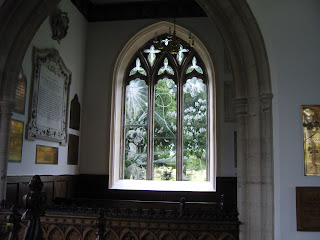Of The Church and churches by Sandra Horn
Is this an odd topic for a blog? Probably. It's an attempt to look at the push-and-pull of churches/religion on me and my writing. I was brought up vaguely C of E but I’m ambivalent about the Church as an institution these days. I used to
be sent to Sunday School as a child. What I remember most about it was that
your team got points for everyone who attended so you’d be beaten up by your
team-mates for not turning up. The church was a good mile-and-a-half from home and we would have walked in all weathers, so my attendance was erratic.
My school started each day with a short service and hymns.
Once, not long before Christmas, there was a decoration with holly and a candle
in front of the Headmistress. It caught fire. We were supposed to be praying –
ie with our eyes SHUT. Mine were open, O sin against the Holy Ghost, which is
why I saw the thing going up in flames. What was I to do? If I shouted ‘Fire!’
I’d be caught out. If I didn’t, we could all be immolated. I took the coward’s
way and kept shtum, but luckily one of the teachers smelled smoke, or heard
crackling, or something, opened her eyes and dashed a glass of water over the
flames.
I think I was ambivalent even then, although I loved singing
the hymns – still do, as long as they are not the dreadful tuneless dirges many of the
more modern writers seem to favour. Ear-shrivelling. Midnight Mass on Christmas
Eve, Harvest Festival...very enjoyable markers of the turning year. I also love
some of the legends and have plundered some as a writer – I’ve written stories
around St Cuthbert and his miraculous encounters with various animals and birds
on the islands off the Northumberland coast. Absurd, enchanting fairytales.
Some church buildings are, of course, very beautiful – and
some are absolutely not. Some are designed to make us poor humans feel like
lowly worms – oppressive – like Notre Dame and the Duomo in Florence, and some
are vainglorious, shouting more of the wealth and importance of their patrons
than the glory of God. One of my favourites is the little church at Moreton in
Dorset, with its clear glass windows exquisitely etched by Laurence Whistler.
It’s flooded with light and the countryside is visible all around. I hadn’t
realised how much church interiors can be darkened by stained glass until I
went there. I keep going back for the sheer joy of it.
The church at Minstead, in the New Forest, where Sir Arthur
Conan Doyle ended up being buried, has a gallery for children and poor people
and a shut-off room for the gentry with its own side-door where the servants
could bring dinners in. Historic relics? Not entirely, alas, not yet.
I don’t have much to do with churches or the Church these
days, except recently when I was involved with Salisbury’s St Thomas’s Church 800th anniversary celebrations. I
belong to a Women’s Theatre Group, Juno, based in Salisbury, and we had been
asked to kick off the celebrations with ‘Salisbury Tales’ which were a series
of monologues and two-handers tracing the history of the church and its place
in the community locally and more widely (it’s a pilgrim church). It has a wonderful
Doom painting over the chancel arch, with a glorious Satan, half cockerel, half
crocodile. Its colours are somewhat faded, as it was covered in whitewash for
years to protect it from being pickaxed by the Iconoclasts, and cleaning it
inevitably caused some damage to the pigments. It’s still a dramatic feature,
though, with its ancient imagery looming over the much newer children’s play
area and tea bar.
Salisbury Tales began with the earliest pilgrims and ended
with the man installing a new audio system and one of those lovely women of the
flower rota and the teas. Some of the writers were new to it and were mentored,
which gave us the chance to sort out a 13th-century pilgrim
referring to ‘egocentric’ Kings, and the use of ‘O God, you search me and you
know me’ set to one of the aforementioned tuneless dirges when it would have
been plainsong, most likely. Instead, we had several people planted amongst the
congregation/audience whispering the words. Nice and atmospheric.
Salisbury Tales cast
The character in my monologue was Martha, the Holy Duster –
a kind of Everywoman, who spoke a prologue and epilogue and all the linking
material between the plays. With her broom and her pinny, she could have been
from any age of the church; a fallen woman earning her redemption and her dole by keeping
the floor swept and the pews dusted. Grateful if slightly baffled by the
sermons and the rituals. For her, as for many, the church was and is a kindly,
forgiving refuge. A place of safety and solace when plague ravaged the city, a
welcoming place for a cuppa and a chat nowadays. – and a focus of caring and
outreach during the recent poisonings and their aftermath. I get all that, but still I’m on the outside
looking in.


Comments
I agree with you that all that traditional C of E inheritance must have an effect on one's writing; and if studying literature, it certainly helps to know some of the bible stories!
Cologne Cathedral, on the other hand, although very lovely from the outside, literally took my breath away as we went in - there were so many candles not far from the entrance that they brought on my asthma and I had to make a hurried exit!
Thank you,
Valerie